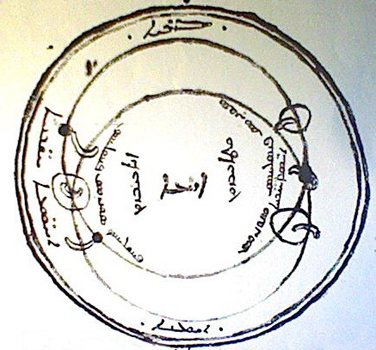Mathematical Astronomy
Being a Scientist and a Christian? Astronomical Syriac texts 500-670 A.D.
Within the research project “Mathematical astronomy in Babylonia” Emily Villey investigates how the sky and the earth are represented in astronomical texts written during Late Antiquity
 |
 |
Astronomical Syriac texts of the 6th and 7th century
Embedded in the work of the research group D-1 “Space of nature” the French scholar Emilie Villey translates and investigates astronomical Syriac texts of the 6th and 7th century. At this time Syriac language – originally derived from an Aramean dialect – had developed in a Christian context into an independent language with its particular lettering.
The oldest Syriac manuscripts we know of were written in the 5th century A.D. But there is no evidence that Syriacs produced astronomical texts before the beginning of that century, since all investigated texts cover the period from 500-670. The project focuses among others on the astronomical texts of Severus Sebokt, who especially wrote a tract about the astrolabe in 662. The first known text about the astrolabe was written by John Philoponus of Alexandria (490-570). In Late Antiquity Alexandria was an important center of astronomy, Severus frequently refers to Claudius Ptolemy (c. 90 – c. 168) and Theon of Alexandria (c. 333 – c. 405) as authorities. It is quite possible that Severus even had travelled to Alexandria to receive an education as astronomer and philosopher.
Villeys research concentrates on manuscripts in 10 European libraries, where at least 20 astronomical Syriac texts produced before the 8th century can be found, some of which comprise more than 100 pages. One manuscript, a copy of the Severus Sebokt tract about the astrolabe, is kept in the Staatsbibliothek (National Library) in Berlin. Villey pursues an extensive comparison of all three versions of this tract, especially as the Paris and the Turkey versions are longer than the Berlin version. All manuscripts are written on paper, the oldest dates from the 10th century.
The particular importance of the Syriac texts becomes obvious when put in relation to some Greek Christian authors of this time: during the period in question most of the Christian authors rejected the spherical model of the world cosmos for ideological reasons in favor of a flat world with a cubic sky (as one of them, Cosmas Indicopleustes, accurately described it in his Christian Topography). At this time the link between astronomy and astrology was so strong that the precise study of the sky could have been perceived as a threat to the Christian doctrine of the free-will. Therefore it was impossible for a lot of them to accept astronomy within the Christian faith.
In contrast to most Greek Christian authors some Syriacs declared that seriously studying astronomy and being a good Christian at the same time was quite possible. Unfortunately their texts have remained literally unknown, because only two of them had been translated and edited before Villey translated another four of them in her Ph.D. A main purpose during her two years in Topoi will be to pursue the work of edition and translation of these texts. She expects that these investigations will fundamentally qualify the established opinion that from the 5th century on there was a “Dark age”, in which Christianity had completely damned astronomy as a “heretic” science. It has already become clear that Christian scholars had a much more differentiated approach towards astronomy than was widely assumed. Unfortunately most of the ancient Arabian astronomical texts, written during the Abbasid Kingdom under the caliph al-Ma’mun (813-833) have not been published yet. Therefore it is difficult at present to judge the extent of reception of Syriac literature by Arab scholars. Their translation and edition should facilitate further research on the history of astronomy in future.
Emily Villey has been recruited since 1st January 2013 as a postdoctoral fellow in the research group (D-1) Space of Nature where she works in collaboration with Gerd Graßhoff, Mathieu Ossendrijver and Elisabeth Rinner, who are specialists of ancient astronomy and geography.
Research project (D-1-5) Diffusion of Science
